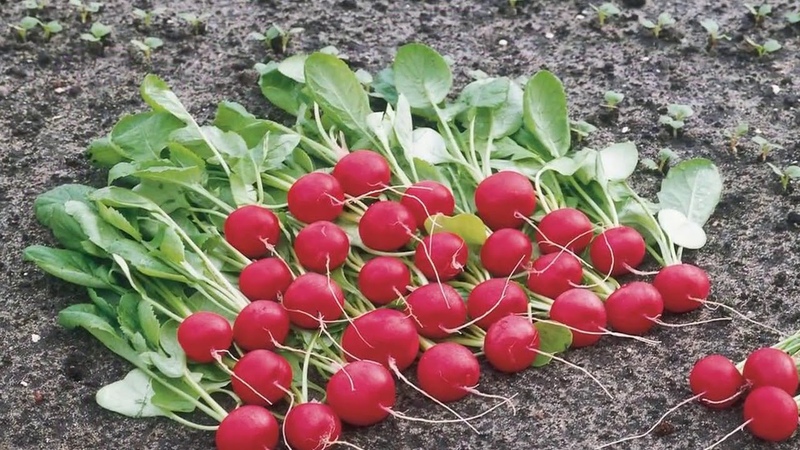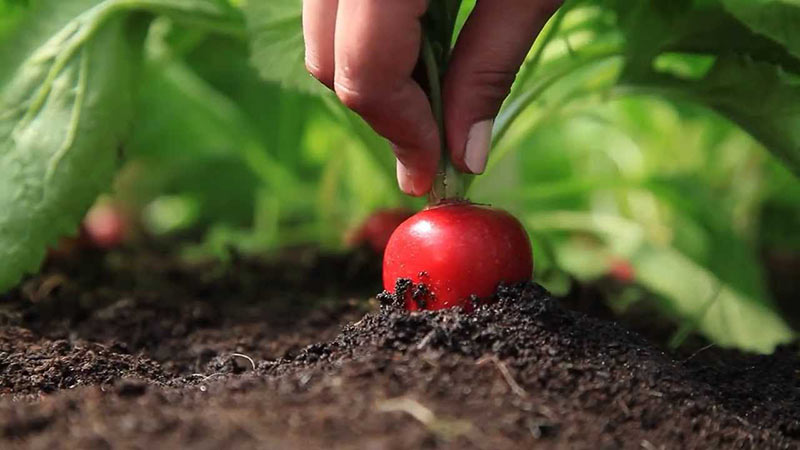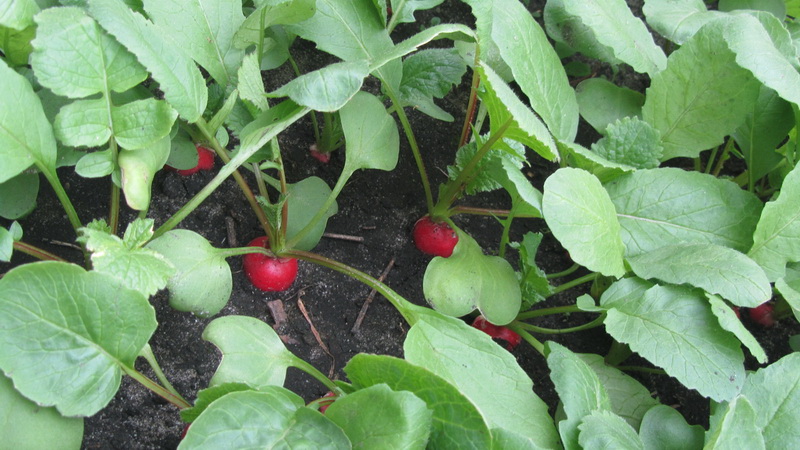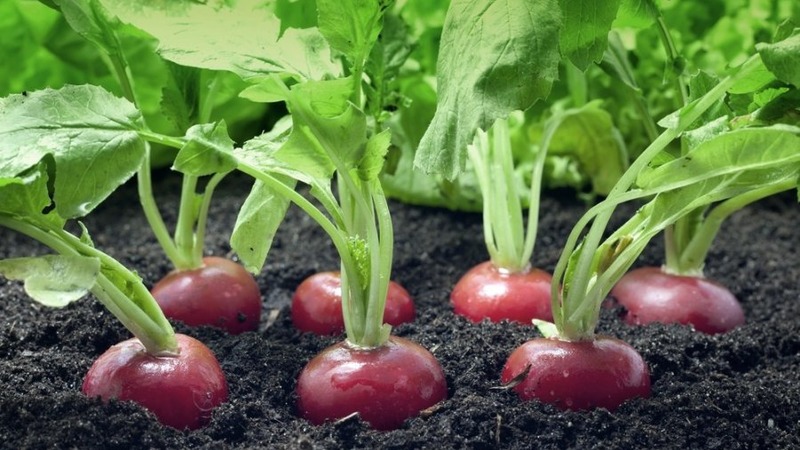Radish growing technology from A to Z for beginner gardeners
Perhaps every gardener at least once was engaged in the cultivation of radishes on their site. It is an unpretentious and low maintenance culture. However, it is not as simple as it seems. It was the radish that was chosen for research in space. With its help, the ISS studied the features of growing plants in zero gravity.
Nevertheless, difficulties arise in the cultivation of such an unpretentious culture. Either the seeds do not sprout, the pests attack, or the root crops grow empty and tasteless. Therefore, we will talk in detail about how to grow radishes in the summer in the open field and in a greenhouse, at what temperature and how this culture grows, how to thin out and how often to water landing.
The content of the article
Choosing a variety

There are a great many varieties of radish. There are those who eat not only root vegetables, but also tops. Let's consider some of the varieties in more detail.
Interesting fact. Radish was brought to Russia by Peter I at the end of the 17th century.
For greenhouse
The correct choice of variety is especially important when grown in greenhouse conditions. For sowing in a greenhouse, choose a radish that is resistant to lack of lighting and high humidity:
- Alex... Ultra-early variety ideal for greenhouses and greenhouses. From the moment of germination to maturity, 16-18 days pass. Root crops are medium-sized, have excellent taste. Not prone to shooting and lignification.
- French breakfast... Fruits are white-pink, cylindrical. The crop ripens in 3-4 weeks. The variety is unpretentious. Grows well in greenhouses, for example between tomatoes.
- Greenhouse Gribovsky... An early ripening variety with amicable ripening. Fruits are red in color, without a white tip.
- Celeste F1. High-yielding Dutch hybrid - yields about 3 kg per 1 m². Unpretentious. Root vegetables with a diameter of about 5 cm with a pleasant taste and slightly pronounced bitterness. Ripens in 25 days from the moment of germination. Doesn't require additional lighting.
- Sachs RS. The variety is distinguished by medium-sized bright red roots. The harvest ripens on the 30th day. The pulp is white, sometimes white-pink. Plants are distinguished by short tops.
- Globe F1... Ultra-early hybrid, from germination to harvest takes an average of 18 days. The pulp is white, slightly spicy, crispy.
For open ground
For growing outdoors, the following varieties are chosen:
- Sora... An early Dutch variety. Sowed from March to September. Does not shoot and does not need additional shelter from the sun. Root crops are round, dark red, juicy. The mass of one reaches 25 g.
- Octave... Rounded smooth white roots with firm pulp and poor pungency. Weight - up to 25 g. Fruit diameter - 3-4 cm. Resistant to flowering.
- White icicle... The variety resembles a daikon, it is convenient for cutting into salads. The pulp is distinguished by a pronounced bitterness. Ripens in 35-40 days. Unpretentious, yields a crop several times per season. The length of the roots reaches 15 cm.
- Red giant... Mid-season variety. A distinctive feature is good keeping quality (up to several months). Ripens in 30-50 days. Large vegetable, weight - 0.3 kg.
- Zlata. The early variety has a golden color. The root crop has a rough surface. The ripening period is 3-4 weeks. A medium sized radish weighs 20g.
Landing dates

Radish seeds are sown:
- First time - either before winter, or in early spring.
- The second time - in late May - early June.
- The third is in early July. It is important to take into account that long daylight hours and hot weather lead to plant growth and a decrease in taste.
- The last time radishes are sown in late August - early September. At this time, sowing is carried out in greenhouses and hotbeds, which have been freed from peppers, tomatoes or cucumbers.
- In greenhouse shelters and greenhouses, radishes are sown from February to April and from August to November.
Growing technology
Growing radish is a simple process, but there are a few things to consider. First, the culture loves short daylight hours. Secondly, the quantity and quality of the crop is influenced by the moisture content in the soil, the availability of necessary nutrients and temperature. Therefore, let us dwell on the technology of growing radish in more detail.
Seed and soil preparation
When cultivated in a greenhouse or greenhouse, radishes are sown without preliminary seed preparation. At an average temperature in the shelter of + 20 ° C, seedlings appear in 4-5 days.
When grown outdoors, seeds are germinated. This allows you to get quick shoots, which means an earlier harvest.
To germinate the seeds, they are wrapped in a napkin and placed in a container with a little warm water. Sprouts appear in 2-3 days. After that, they start sowing.
A garden bed for radishes is prepared in the fall. They dig up the earth, add compost, humus, rotted manure. Peat or sand is added to clay soil.
Radish grows well on neutral soils, in extreme cases slightly acidic is allowed.
The sowing site is chosen in a sunny, wind-protected place. For early spring crops, the southern and southeastern sides are preferred, where the ground thaws faster.
Important! Radish is an excellent predecessor for many garden crops. Tomatoes, potatoes, peppers, cucumbers are planted after it. Sowing radishes in a new location each year will improve your crop rotation.
The exceptions are cruciferous plants such as cabbage, mustard, and watercress. They transmit diseases of this family to subsequent plantings.
Sowing
On the prepared beds, grooves are marked and shed well with warm water. A palm-width distance is maintained between the grooves. Seeds are laid out at the bottom and covered with a 2-centimeter layer of earth.
After the emergence of seedlings, the crops are thinned out, leaving about 4-5 cm between neighboring plants.
Care

Caring for the planting of radish is timely watering, loosening the soil, thinning crops and applying fertilizers.
Thinning of seedlings is carried out 5-6 days after the emergence of shoots. The distance between them is left based on the large-fruited variety.
Regular watering is important for the formation of a correct, juicy root crop. The first time the crops are watered immediately when shoots appear. Subsequently, the soil is moistened as the top layer of the soil dries up. Do not forget that excessive moisture leads to rotting of the vegetable.
Loosening of the soil is carried out after each watering, simultaneously removing weeds.
If the land has been prepared in advance, radish plantings do not require additional fertilization. The available food for the vegetable is enough. If the soil is poor, a week after the emergence of seedlings, the radishes are fed with organic fertilizers.
Nuances of agricultural technology
Although radish belongs to unpretentious crops, some nuances should be taken into account when growing it.
In the open field
The place for planting radish choose in such a way that the bed is well illuminated by the sun in the morning and evening. But on a hot afternoon, planting is shaded from the sun's rays with a film.
If the radish beds are in the shade all day, all the growth will go into the tops, and the root crops will grow small and tasteless.
In the greenhouse
When growing radishes in a greenhouse, varieties and hybrids are chosen that are resistant to a lack of sunlight.Both in the heifer and in the open field, plants do not tolerate high temperatures. In order to grow a good and quality crop, the plantings are provided with intensive ventilation.
Hydroponics
For growing crops in a nutrient hydroponic solution, early maturing varieties and hybrids are chosen that can do without bright sunlight. It is preferable to use varieties with round fruits and medium-sized tops, for example, 18 days, Celeste, Carmen.
For cultivation, plastic cassettes with cells 5 × 5 × 5 cm are used. The plantings are compact, and the plants have enough nutrition. The cells are filled with soil or a mixture of 2 parts of perlite and 8 parts of peat.
Pests and diseases

The following pests pose the greatest danger to planting radish:
- Cruciferous flea... It feeds on young leaves of radish, making many holes in them. As a result, plant growth slows down or stops altogether.
- Cabbage White. Caterpillars of this pest are located on the underside of leaves, gradually spreading to neighboring plants. The first sign of the appearance of an insect is twisted leaves with oblong holes.
- Cabbage fly. The danger for radish is represented by insect larvae that damage plant roots.
- Garden scoop... The larvae eat young seedlings, which leads to a cessation of the growth of root crops.
- Wireworm. Eats root vegetables, simultaneously causing the development of fungal diseases and rot.
Plantings of radish and diseases are striking:
- Mucous bacteriosis... The development of the disease is provoked by bacteria that activate in warm, humid weather. First, the tops rot and the base of the root crop is sluggish, then the rot penetrates into the core.
- White and gray rot... These are fungal diseases that affect root crops. They darken and become covered with a bloom of the mycelium of the fungus.
- Keela. A fungal disease affecting all cruciferous plants. The disease is recognized by the appearance of growths and swelling on the roots.
- Blackleg... It affects young shoots. The root collar darkens, becomes thinner and decays, leading to the death of the entire plant.
- Fusarium. Another fungal disease affecting radish tops. It is characterized by yellowing and falling leaves. Sick plants slow down their growth, root crops grow small and tasteless.
Control and prevention measures
To protect plants from pests, the beds are treated with wood ash or tobacco dust. Treatment is particularly effective immediately after watering or rain.
In case of mass destruction, chemical preparations are used to control insects: "Tod", "Alfatsin", "Zolon", "Kaiser", "Arrivo".
Diseases of bacterial origin are treated by spraying with Bordeaux liquid. In case of a keel disease, the soil is watered with milk of lime - 2 tbsp. lime per 10 liters of water. With a black leg, diseased plants are destroyed, and the soil is watered with a solution of copper sulfate.
To prevent the development of diseases, seeds are disinfected before sowing. They are kept in aloe juice, garlic pulp solution, potassium permanganate solution.
Harvesting

Harvesting is done selectively. Early varieties ripen faster, respectively, they are removed from the garden first.
Attention! If the roots of early varieties are kept in the ground for longer than the prescribed period, they deteriorate, become flabby and acquire a bitter taste.
Late varieties of radish ripen longer, but also have better keeping quality. Winter varieties are ready for harvesting 50-60 days after sowing.
Root crops are removed from the ground by gently pulling the tail. The tops are cut immediately after collection. The harvested crop is stored in the refrigerator.
Tips from experienced summer residents
Tips from experienced gardeners will help you grow a tasty and healthy vegetable on your site:
- Cover crops with black film immediately after planting. Remove the cover at 8-9 am and cover the garden again at 6-7 pm. Thus, you will provide seedlings with optimal daylight hours for the development of root crops, and not peduncles.
- In late August - early September, sow radishes in greenhouses and greenhouses that have been freed from other crops. Daylight hours at this time are already less, and the need for a black film disappears.
- When growing in a shelter, provide the plantings with the most favorable average daily temperature - + 20 ° C.
- Don't overdo it with fertilizers. Excessive amounts of nutrients lead to active growth of tops and shooters.
Conclusion
A young, juicy radish is one of the first spring vegetables that delight us in our beds. The culture is unpretentious, but for all the seeming simplicity of cultivation, it is important to adhere to some rules. Compliance with the cultivation technology will provide the family with a stable harvest of vitamin vegetables throughout the summer season.